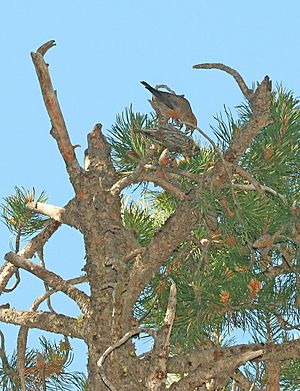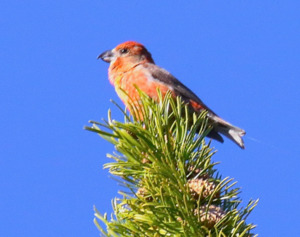Cassia crossbill facts for kids
Quick facts for kids Cassia crossbill |
|
|---|---|
 |
|
| Male and juvenile in a pine | |
| Scientific classification | |
| Genus: |
Loxia
|
| Species: |
sinesciurus
|
The Cassia crossbill (Loxia sinesciuris) is a special type of bird in the finch family. It lives only in the South Hills and Albion Mountains in southern Idaho, USA. This bird has a unique beak that helps it get seeds from lodgepole pine cones in its home.
Scientists first described the Cassia crossbill in 2009. However, it wasn't officially recognized as its own species until 2017. This happened after they found it was very different from other similar birds called red crossbills. It even has its own special calls!
Contents
What Does the Cassia Crossbill Look Like?
The Cassia crossbill looks a lot like its relatives, the red crossbills. Adult male Cassia crossbills are a pretty brick-red color on their head, chest, and belly. Their wing feathers are brown. Female Cassia crossbills are usually a dull green or olive-yellow, also with brown wing feathers.
The most interesting part of this bird is its beak. It's crossed over, which helps it open pine cones. The Cassia crossbill has a deeper and thicker beak than other crossbills. This helps it crack open the very tough lodgepole pine cones found in its habitat. These birds usually weigh between 29 and 44 grams. Their wings are about 8.5 to 10 centimeters long.
Where Do Cassia Crossbills Live?
The Cassia crossbill lives all year round only in the forests of the South Hills and Albion Mountains in southern Idaho. While red crossbills live all over the world, the Cassia crossbill's home is tiny. It's only about 67 square kilometers (26 square miles)!
These birds mostly live in older lodgepole pine forests. They prefer areas where there are no red squirrels. This is because their beaks are perfectly made for a certain type of pine cone. The birds and the pine trees have actually coevolved. This means they have changed together over time, which is why the birds are found in such a small area. Other types of red crossbills sometimes visit these areas, but they rarely stay to breed. This is because their beaks aren't as good at opening these specific pine cones. Because their home is so small, scientists are worried about the future of this species.
How Did the Cassia Crossbill Become Its Own Species?
The Cassia crossbill was first called the South Hills crossbill in 2009. The name "Loxia" means "crosswise," referring to its beak. "Sinesciuris" means "without squirrel," which points to its special habitat.
For a long time, scientists thought it was just one of 10 different "call types" of the red crossbill. These call types had different sounds and slightly different beak sizes. They also ate seeds from different types of pine trees. In 2016, new studies showed that the South Hills crossbill was genetically different from other crossbills. It was also clear that it had a special relationship with the lodgepole pine trees. This is an example of sympatric speciation, where a new species forms in the same area as its parent species.
In 2017, scientists officially recognized it as a separate species. They renamed it the Cassia crossbill because it lives in Cassia County, Idaho.
Cassia Crossbill Behavior
What Do Cassia Crossbills Eat?
Cassia crossbills eat only lodgepole pine seeds from cones found in their specific region. They can survive in such a small area because there are no squirrels there. Squirrels usually eat a lot of pine seeds. Because there are no squirrels, many cones with seeds build up and last for decades.
This has led to a special "arms race" between the crossbill and the pine tree. The crossbill is the main animal eating the seeds. So, the lodgepole pine trees have evolved to make cones with very thick scales. In response, the crossbills have evolved deeper beaks to open these tough cones! Younger cones (1-10 years old) are harder to open. Older, weathered cones are easier because their scales start to separate.
Crossbills mostly eat seeds from cones still on the tree. But they will also eat seeds from fallen cones. They use their crossed beak to pry open the cone. Then, they use their tongue to get the seed. Finally, they use a groove in their mouth to shell the seed before eating it.
How Do Cassia Crossbills Communicate?
The Cassia crossbill used to be known as call type 9 of the red crossbill. Young Cassia crossbills first copy their parents' calls. Later, they change their calls to sound like their mate.
Compared to other crossbills, Cassia crossbills sing more repetitive songs with fewer syllables. Their songs often have buzzing notes and short silences between phrases. They also make sharp "chip" and "kip" calls. Sometimes, different types of crossbills will forage together. It's thought that crossbills listen to each other's calls to find food easily. This might have helped the Cassia crossbill become its own separate species.
How Do Cassia Crossbills Reproduce?
Cassia crossbills usually only mate with other Cassia crossbills. From 2001 to 2006, less than 1% of Cassia crossbills mated with other types of crossbills. Unlike red crossbills, which can breed almost any time of year, Cassia crossbills consistently breed from March to July.
They build cup-shaped nests in April using twigs, grasses, and pine needles. During courtship, the male bird sings, flies, and feeds pine seeds to the female. After mating, the male will protect the female from other males. Females lay 2 to 6 eggs and sit on them for 12 to 16 days until they hatch.
Protecting the Cassia Crossbill
Scientists estimate there are about 5,800 Cassia crossbills in total. Since it's a newly recognized species, its conservation status hasn't been fully assessed yet. However, based on the IUCN Red List rules, it would likely be considered critically endangered. This is because it lives in such a small area, has a small population, and its home is at risk.
A big threat to the Cassia crossbill is climate change. Hot weather can make pine cone seeds fall early, meaning less food for the birds. Warmer weather also leads to more mountain pine bark beetle attacks. These beetles kill pine trees, which further reduces the birds' food supply. Also, the risk of large fires increases each year due to climate change. If a big fire destroys many pine trees, it could be disastrous for the crossbills.
It's predicted that lodgepole pines might disappear from the South Hills and Albion Mountains by the end of this century. The 2020 wildfires already burned a large part of the South Hills. This could mean the Cassia crossbill population has already lost half its numbers.
See also
 In Spanish: Piquituerto de Cassia para niños
In Spanish: Piquituerto de Cassia para niños


